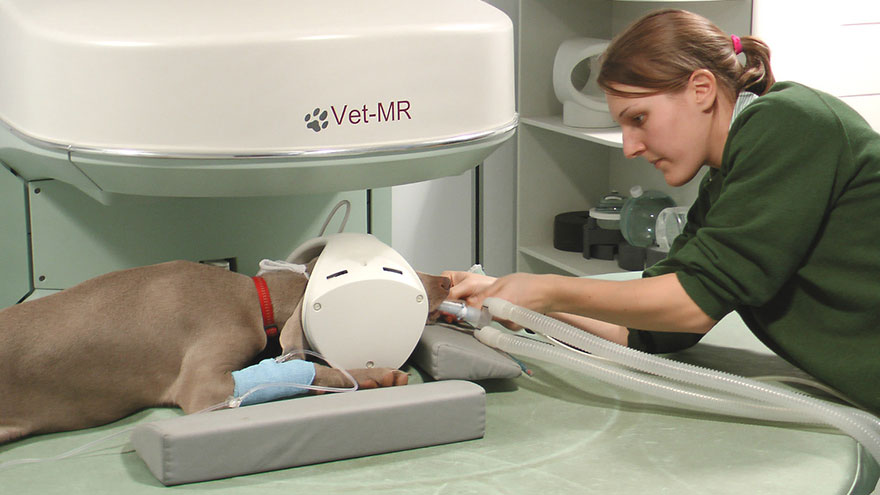MRI Scans for Dogs
A number of diagnostic imaging tests are available to veterinarians, including radiographs, ultrasounds and echocardiograms. The most advanced technology being utilized with increasing frequency is MRI. This safe, noninvasive and painless imaging technique offers views of an organ’s interior structures without the need for exploratory surgery to attain a diagnosis.

Magnetic Resonance Imagery
MRI is achieved through a combination of radio waves and magnetic fields. The radio waves displace the body’s hydrogen molecules out of alignment. As the molecules drift back into alignment, the cells emit an electrical pulse. This pulse, or signal, is detected by a powerful magnet in the MRI machine, which transmits the signals to a computer, where they are converted into the images that are examined by the veterinary radiologist.
MRI produces cross-sectional scans and takes images from multiple angles of the target area. In some cases, a contrast dye will be administered to the patient before the images are taken. Although MRIs are noninvasive, they must be performed on dogs who are anesthetized. The MRI machine generates sounds that may frighten an animal, and the patient must lie perfectly still throughout the scanning procedure.
Diagnostic Goals
The resulting images from an MRI test offer clear and detailed pictures of a patient’s internal organs, soft tissue, neural tissue and musculoskeletal structures to enable accurate diagnosis. It is the preferred diagnostic imaging method for detecting diseases and injuries of the brain and spinal cord, including:
- Spinal disk herniation.
- Intervertebral disk disease.
- Brain tumors.
- Peripheral nerve disorders.
- Nasal and inner ear tumors.
MRI is also a valuable tool in assessing the extent of metastasis in cancer patients so the most effective cancer treatment plan can be determined. MRI also is used to evaluate a pet’s joints, including bones, tendons, ligaments and soft tissue, when the cause of limping cannot be diagnosed with radiographs alone.
The MRI Procedure
Because the MRI equipment is expensive to purchase, house, maintain and operate, most general practice veterinarians do not have these machines. If your veterinarian recommends an MRI, he or she likely will refer you to a veterinary specialist facility. Before the day of your scheduled appointment, be sure to acquire a copy of your dog’s medical history, including recent laboratory test results and any radiographs that have been taken.
The veterinarian to whom you are referred will want to have all of the pieces of the puzzle when evaluating your dog’s case and the MRI results. You will need to withhold your dog’s food, starting the evening prior to the appointment. Once your dog is admitted into the hospital for the procedure, an intravenous catheter will be placed and fluid therapy will commence. This helps to keep your dog’s blood pressure up while under anesthesia and helps to flush the anesthetic agents from his system more rapidly. Once he is anesthetized, the MRI scans are taken.
The imaging process can take as long as an hour to complete. Afterward, your dog is placed in a recovery ward where he will be monitored as he awakens from the anesthesia. The recovery time varies with each patient, but you can expect to be reunited with your dog when he is discharged from the hospital later that day. The MRI images will be evaluated by a board-certified veterinary radiologist.
Contraindications and Risks
Due to the strong magnetic power of the MRI machine, patients who have pacemakers or metallic implants cannot undergo MRI imaging. Animals who are being treated for trauma and hooked up to life support devices should not undergo MRI testing because the magnetic field may render these critical machines nonfunctional.
MRI is a safe imaging method. Ionized radiation is not utilized in MRI. The only risks associated with MRI screening are anesthetic complications. Precautions, such as performing preanesthetic blood panels, monitoring vital signs while your dog is under anesthesia and administering intravenous fluid therapy, are all taken to minimize the anesthetic risks. If your veterinarian has recommended an MRI for your furry friend, be sure to address all of your questions and concerns with him or her and with the veterinary specialty center staff before your scheduled appointment.
You Might Also Like :: Sub-Q Therapy in Dogs for Kidney Failure

